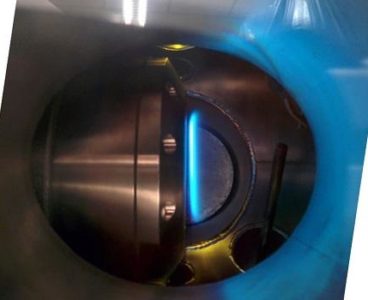New methods of arranging silver nanowires make them more durable, shows a study by KAUST. These nanowires form flexible, transparent conductive layers that can be used for improved solar cells, strain sensors and next-generation mobile phones. Applying nanotechnology in electronic devices requires rigorous testing of individual tiny components to ensure they will stand up to…
Chemical Industry Bottleneck Gets a Colorful Solution
The nanoscale water channels that nature has evolved to rapidly shuttle water molecules into and out of cells could inspire new materials to clean up chemical and pharmaceutical production. KAUST researchers have tailored the structure of graphene-oxide layers to mimic the hourglass shape of these biological channels, creating ultrathin membranes to rapidly separate chemical mixtures.…
Lasers, Graphene Form Tailor-Made Marine Sensors
A flexible, lightweight and robust salinity sensor that can be attached to aquatic animals for long-term monitoring of their habitat has been developed by a multidisciplinary team at KAUST. The team created a sensor that accurately records salinity even after long-term submersion. The sensor can form the basis of a marine animal monitoring device that…
Dataset Size Counts for Better Predictions
Briny Pool Bacteria Can Clean Up and Power Up
Warm and salty wastewater is a by-product of many industries, including oil and gas production, seafood processing and textile dyeing. KAUST researchers are exploring ways to detoxify such wastewater while simultaneously generating electricity. They are using bacteria with remarkable properties: the ability to transfer electrons outside their cells (exoelectrogenes) and the capacity to withstand extremes…
Study Highlights Favorable Areas for High-Altitude Wind Energy Systems
The notion of tethered wind turbines that generate electricity from abundant and reliable high-altitude winds seems futuristic. Now, KAUST research led by Georgiy Stenchikov has identified the most favorable areas for high-altitude wind-energy systems in the Middle East. The results confirm that there is abundant wind energy up there that could feasibly be harnessed, bringing…
Letting the Data Speak for Itself
No Strings Attached for Underwater Video System
A flexible and cost-effective technology for streaming high-quality underwater video images has been developed by researchers at KAUST by improving the bandwidth to achieve better video quality. Oceans cover more than two-thirds of our planet and are a major source of biodiversity, food and medicines as well as containing vast reserves of oil, gas and…
Gazing into the Flames of Ionic Winds
The ability to precisely control flames could lead to greater energy efficiency and fewer harmful emissions from transport and industry. Flames contain charged ions and electrons, which can be manipulated using electricity. KAUST researchers have now produced the first detailed 3D visualizations of ionic winds flowing from a flame in response to both direct (DC)…
Novel Microporous Material Regulates Temperature
A novel porous material can soak up excessive humidity in a room only to release it again when the humidity falls. Now KAUST researchers have devised a metal-organic framework (MOF) material that monitors its own properties. MOFs are a class of microporous materials consisting of single metals or metal clusters connected by organic linker molecules.…
Keeping The Heat Out
Nanoparticles Take a Bite Out of Infection
Using Sunlight to the Max
Materials called transition-metal carbides have remarkable properties that open new possibilities in water desalination and wastewater treatment. A KAUST team has found compounds of transition metals and carbon, known as a MXenes but pronounced “maxenes,” can efficiently evaporate water using power supplied by the sun1. Renyuan Li, a Ph.D. student at KAUST, has investigated a…
A Changing Climate Affects Plankton Populations
Bacterial and archaeal plankton, as the most abundant form of life in the oceans, profoundly influence the global environment. Based on a broad survey of the seas, researchers from KAUST have developed a model that predicts how climate change might affect these microbial populations1. Temperature, nutrient availability and mortality rates are three primary factors that…
The Brighter Side of Twisted Polymers
A strategy to produce highly fluorescent nanoparticles through careful molecular design of conjugated polymers has been developed by KAUST researchers. Such tiny polymer-based particles could offer alternatives to conventional organic dyes and inorganic semiconductor quantum dots as fluorescent tags for medical imaging. Conjugated polymer-derived nanoparticles, called Pdots, are expected to transform several areas, including optoelectronics,…
Gold Standards for Nanoparticles
Expanding the potential of gold nanoparticles for a range of uses requires methods to stabilize the clusters and control their size. Researchers at KAUST reveal how simple organic citrate ions, derived from readily available citric acid, can interact with the gold atoms to yield the stable nanoparticles needed for further research. Such clusters of gold…
Rolling Out an E-Sticker Revolution
The healthcare industry forecasts that our wellbeing in the future will be monitored by wearable wirelessly networked sensors. Manufacturing such devices could become much easier with decal electronics. A KAUST-developed process prints these high-performance silicon-based computers on to soft, sticker-like surfaces that can be attached anywhere1. Fitting electronics on to the asymmetric contours of human…
Divide and Conquer Pattern Searching
Searching for recurring patterns in network systems has become a fundamental part of research and discovery in fields as diverse as biology and social media. KAUST researchers have developed a pattern or graph-mining framework that promises to significantly speed up searches on massive network data sets. “A graph is a data structure that models complex…
The Promise of Greener Power Generation
Modeling the combustion of fossil fuels by KAUST researchers has helped to characterize some of the components of methane, laying the foundations for greener power generation1. In energy production, incomplete combustion of fossil fuels, like natural gas, causes the release of air pollutants, such as soot, carbon monoxide, and nitrogen oxides, which are harmful to…



















